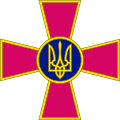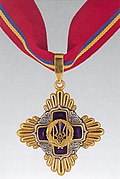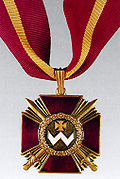Ukrainian Ground Forces
| Ukrainian Ground Forces | |
|---|---|
| Сухопутні Війська України | |
 Emblem of the Ukrainian Ground Forces | |
| Active | 1917–1922, 1991–present |
| Size | 169,000 as of 2016[1] |
| Part of | Armed Forces of Ukraine |
| Headquarters | Kyiv |
| Anniversaries | Army Day (6 December)[2] |
| Engagements | Ukrainian–Soviet War Polish–Ukrainian War Kosovo Force (KFOR) 1999 East Timorese crisis Iraq War War in Afghanistan Russian invasion of Crimea War in Donbas |
| Commanders | |
| Commander of the Ukrainian Ground Forces | Colonel General |
| Insignia | |
| Ensign | 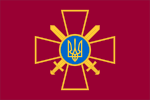 |
The Ukrainian Ground Forces (Ukrainian: Сухопутні Війська ЗСУ Sukhoputni Viys’ka [ZSU]) are the land force component of the Armed Forces of Ukraine. They were formed from Soviet Ground Forces formations, units, and establishments, including three military districts (the Kyiv, Carpathian, and Odessa Military Districts), that were on Ukrainian soil when the Soviet Union collapsed.
Since Ukraine's independence from the Soviet Union in 1991 Ukraine retained its Soviet-era army equipment. Also, the Armed Forces have been systematically downsized since 1991 and as a result it was largely dilapidated in July 2014.[3] Since the start of the war in Donbas in April 2014 in eastern Ukraine, Ukraine continues to upgrade its Armed Forces.[3][4][5] Its size of 129,950 in March 2014[6] had grown to 204,000 active personnel in May 2015,[7] with the Ground Forces branch having 169,000 soldiers as of 2016.[1] In 2016, 75% of the army consisted of contract servicemen.[8] Ukraine's ground forces have also received more modern tanks, APCs, and many other types of combat equipment.[9]
History[]
Prior to the October Revolution of 1917, three separate self-governing Ukrainian states existed on what is Ukraine today. Each of these states possessed armed forces. The largest of these, the Ukrainian People's Republic, itself comprised three separate regimes. The Ukrainian People's Army is an example of one of the early national armed forces. Other armed independence movements existed in the wake of both the First World War and the Second World War, and these armies each had distinct organisation and uniforms. These armed forces, and the independent Ukrainian homeland for which they fought, were eventually incorporated into the neighboring states of Poland, Soviet Union, Hungary, Romania and Czechoslovakia.[10]
Collapse of the USSR[]
On their establishment in 1991, the Armed Forces of Ukraine included approximately 780,000 personnel,[11] 7,000 armored vehicles, 6,500 tanks, and 2,500 tactical nuclear missiles. However, the problem that Ukraine face was that while it had vast armed forces, it lacked a proper command structure. Therefore, on 24 August 1991, the Verkhovna Rada of Ukraine ratified the resolution of taking under its control, all military units of former Soviet Armed Forces, situated on the territory of Ukraine; and in turn the establishment of the Ministry of Defence of Ukraine.
Creation of the Ground Forces[]
| |||||||||||||||||||||||
Following the declaration of Ukrainian independence in 1991, Ukraine inherited the 1st Guards Army, 13th Army, 38th Army, two tank armies (the 6th Guards Tank Army and the 8th Tank Army), and the (32-й Кенигсберский армейский корпус) at Simferopol. In addition, the 28th Guards Motor Rifle Division (MRD) and the 180th MRD were left in Ukraine, having been previously under the 14th Guards Army headquartered at Tiraspol in the Moldovan SSR. The post of commander of ground troops was designated in early 1992. By the end of 1992, the Kyiv Military District disbanded, and Ukraine used its structures as the basis for the Ministry of Defence and the General Staff.[12] Between June and August 1993, the first redesignation of armies to army corps appears to have taken place.[13] While the chief of ground forces post had been created in early 1992, it was over two years before the first holder, Colonel General , was appointed on 7 April 1994.[14] The legal framework for the Ground Forces was defined in Article 4 of the law 'On the Armed Forces of Ukraine.' At that time, the Ground Forces had no separate command body, and were directly subordinate to the Ukrainian General Staff.
The creation of the Ground Forces as a separate armed service was enacted by Presidential Decree 368/96 of 23 May 1996, 'On the Ground Forces of Ukraine.'[15] That year both the Ground Forces Command was formed and the 1st Army Corps was reorganised as the Northern Territorial Operational Command (which became the Northern Operational Command in 1998). In 1997 the Carpathian Military District was reorganised as the .
From 1992 to 1997, the forces of the Kyiv MD were transferred to the Odessa MD, and the Odessa MD's headquarters moved to Donetsk.[16] A new 2nd Army Corps was formed in the Odessa MD. Armies were converted to army corps, and motor rifle divisions converted into mechanised divisions or brigades. Pairs of attack helicopter regiments were combined to form army aviation brigades.
President Leonid Kuchma revealed in a December 1996 speech that as many as 191 mechanised infantry and tank battalions were rated not ready, adding,"This is especially dangerous in the forward-based units securing the nation's borders."[17]
Reform[]
According to a plan promulgated in 2000 the Ground Forces were to reduce the number of troops from the then 300,000 to 240,000 by 2015, and an ultimate change from a partial conscript-based force to a fully professional military.[18] The Armed Forces received little more than half of the Hr 68 million it was promised for reform in 2001, but managed to disband nine regiments and close 21 local military bases.[nb 1]
In 2005–06, the Northern Operational Command was reorganised as Territorial Directorate "North". It was tasked with territorial defence, mobilisation training, and preparation of reserves.[19][nb 2]
From 1991 the Ukrainian Ground Forces bought its military equipment only from Russia and other CIS states, as well as locally producing some of their own equipment.[3][4] Until 2014 and the start of the war in Donbas, the defence industry in Ukraine produced equipment mostly for export.[21][3]
Russian occupation of Crimea[]
In the aftermath of the 2014 Ukrainian Revolution, Russian special forces in unmarked uniforms began surrounding Ukrainian military bases on the Crimean peninsula before capturing them individually using a mixture of attrition and threats.[22] Over the following weeks the Russian Armed Forces consolidated control of the peninsula and established road blocks to cut off the possibility of Ukraine sending reinforcements from the mainland.[23] By the end of March, all remaining Ukrainian troops were ordered to pull out of Crimea.[24] The Ukrainian Army was considered to be in a poor state during and after the annexation with only 6,000 of its troops ready for combat and many of its vehicles lacking batteries.[25] After Russia's annexation only 6,000 of the 20,300 Ukrainian soldiers stationed in Crimea before the annexation left the peninsula. The rest stayed in Crimea.[26]
War in Donbas[]
In the early months of the war in Donbas that erupted in 2014 the Armed Forces were widely criticised for their poor equipment and inept leadership, forcing Internal Affairs Ministry forces like the National Guard and the territorial defence battalions to take on the brunt of the fighting in the first months of the war.[27][28]
By February 2018 the Ukrainian armed forces were larger and better equipped, numbering 200,000 active-service military personnel and most of the volunteer soldiers of the territorial defence battalions were integrated into the official Ukrainian army.[29]
Within the reporting period of 16 November 2017 to 15 February 2018 a United Nations OHCHR monitoring mission documented 115 cases of credible allegations of human rights abuses committed on both sides of the contact line.[30] The nature of the crimes ranges from enforced disappearances, looting of civilian property, torture, rape and sexual violence up to political repression and extrajudicial killings.[30]
Military training and education centers[]


Training in 2006 was aimed at developing mobility and combat readiness of the forces.[31] The Ukrainian armed forces took advantage of the opportunities provided by UN exercises and exercises where Ukraine and NATO nations and other partners participated.[31][32]
Training resulted in 6,000 combat-ready troops in the spring of 2014 of Ukraine's (then) 129,950 active military personnel.[25][33] In 2016 the Ukrainian army had more than 200,000 combat-ready soldiers of its 260,000 active personnel.[7][34]
In 2015 Ukraine, the United States, the United Kingdom and Canada established the Joint Multinational Training Group – Ukraine (JMTG-U) and they set up three new training sites, in Khmelnytskyi, Yavoriv and Kamianets-Podilskyi.[34]
Education centers[]
In 2007 the system of exercise/training ranges was optimized, decreasing their number and providing a specialized role.[35]
Schooling occurs at:
- 169th Training Center – (Desna / 50°55'35"N 30°45'27"E) – Home to army initial training, for all personnel entering the Army, it also houses the 169th Teaching Brigade which specializes in the tactics and skills of tankers and mechanized/motorized infantrymen.
- Hetman Petro Sahaidachnyi National Ground Forces Academy – (Lviv / 49°49'28"N 24°1'2"E) – It is an academy for all officer cadets seeking a commission, an equivalent of the American West Point and British Sandhurst.
- Ivan Chernyakhovsky National Defense University of Ukraine – (Kyiv / 50°25'57"N 30°27'52"E) – Teaches specializations like foreign languages, book keeping, cryptology, study of armaments, logistics, etc.
- Ivan Bohun Military High School – (Kyiv / 50°25'24"N 30°32'43"E) – A JROTC style boarding school which has a curriculum identical to Ukraine's public schools with added focus on military teachings and discipline.
- Korolev Signals Institute – (Zhytomyr / 50°17'6"N 28°36'54"E) – Teaches theory and practice of electromagnetic waves and their uses in communication, radio location, eavesdropping, and jamming.
- Military Institute of Telecommunications and Information Technologies – (Kyiv / 50°25'18"N 30°33'25"E) – Teaches the subjects: Computer Science, Systems engineering, Telecommunications, Security Information and Communication Systems, Systems of technical protection of information, Electronic military administration.[36]
- Odessa Artillery Academy
Training ranges are at:
|
|
|
Branches of the Ground Forces[]
Armoured and mechanised forces[]


Mechanised Infantry and armoured forces are the primary components of the Ukrainian Ground Forces. Their primary objectives in case of war are capturing and holding targets, maintaining positions, defending against attack, penetrating enemy lines and defeating enemy forces.
The mechanised and armoured forces are equipped with a combination of Soviet-made (part of them modernized) and modern Ukrainian armored vehicles which includes T-80, T-64,[37] (T-64BV Model 2017, T-64BV), T-64BM "Bulat"[38] and T-72UA1 main battle tanks,[39][40][41] BTR-4, BTR-60, BTR-70 and BTR-80 wheeled armored personnel carriers and BMP-1, BMP-2 and BMD-2 infantry combat vehicles.
Since the fall of the Soviet Union, a large number of the previous Soviet mechanised formations on Ukrainian soil have been disbanded – the IISS says totals have dropped from 14 divisions, in 1992, to two divisions, six brigades, and one independent regiment in 2008.[42] Today, all mechanised and armoured formations are called brigades.
Mountain and Jager Brigades[]
The Ukrainian Ground Forces also include two mountain infantry brigades and the newly formed 61st Jager brigade, reformed from the 61st Motorized Infantry in 2019.[43]
- 10th Mountain Brigade
- 128th Mountain Brigade
- 61st Jager Infantry Brigade
Army Aviation Regiment[]
Army Aviation provides reconnaissance, tactical fire support and air transport for the Ukrainian Ground Forces. As of 2017 Ukraine's army fields four Army Aviation brigades:
- 11th Army Aviation Brigade, Kherson
- 12th Army Aviation Brigade, Novyi Kalyniv
- 16th Army Aviation Brigade, Brody
- 18th Army Aviation Brigade, Poltava
The Army Aviation's maintenance facility is the 57th Aviation Base in Brody. The service's equipment includes: Mi-2, Mi-8, Mi-9, Mi-24 and Mi-26 helicopters.
Rocket Forces and Artillery[]

Army Air Defence[]
The Army Air Defence units are responsible for protecting troops against enemy air attacks anywhere on the battlefield, and while in combat. The Ukrainian Ground Forces army air defence branch is equipped with a variety of effective surface-to-air missile systems of division level and anti-aircraft missile and artillery complexes of regiment level. Regiment level units are characterized by their high rate of fire, vitality, maneuverability, and capability of action under all conditions of modern combat arms operations. Surface-to-air missile systems and complexes of division level are characterized by their long range and firepower and are equipped with surface-to-air missile complexes; S-300V, Osa, Buk, Buk-M1 and Tor. While anti-aircraft missile and artillery complexes that are of regiment level are equipped with the Tunguska-M1, Igla MANPADS system, Strela, and Shilka anti-aircraft missile systems.[44]
The army's only separate radar system, meaning it isn't a part of any anti-aircraft system, is the Ukrainian Kolchuga-M. It was designed sometime between the years 1993–1997, the system is said to be one of the most advanced passive sensors in the world, as it is claimed to be able to detect stealth aircraft.[45]
Structure[]
2017 structure of the Ukrainian Ground Forces after the reorganization caused by the Donbas war. It built and expanded on the 2011 structure.[46]
- Ground Forces Command, Kyiv.[47][48]
- "Kyiv" (BM-30 Smerch), Drogobych[47][48]
- 19th Missile Brigade "Zaporizhia" (OTR-21 Tochka-U), Khmelnytskyi[47][48]
- 27th Rocket Artillery Brigade "Sumy" (BM-27 Uragan), Sumy[47][48]
- 38th Artillery Brigade, Popilnia
- 43rd Heavy Artillery Brigade (2S7 Pion), Pereiaslav[47][48]
- 107th Rocket Artillery Regiment (BM-30 Smerch), Kremenchuk
- , Kherson[47][48]
- 12th Army Aviation Brigade, Novyi Kalyniv[47][48]
- , Brody[47][48]
- , Poltava[47][48]
- 169th Training Centre, Desna[47][48]
- ,
- 355th Mechanized Training Regiment
- 356th Artillery Training Regiment
- Tank Training Battalion
- 138th Material Supply Training Battalion
- Anti-Tank Missile Specialists School
- other units
- 1st Independent Presidential Guard Regiment, Kyiv[47][48]
- Operational Command West, Rivne[47][48]
- 10th Mountain Assault Brigade, Kolomyia[47][48]
- 14th Mechanized Brigade, Volodymyr-Volynskyi[47][48]
- 24th Mechanized Brigade, Yavoriv[47][48]
- 128th Mountain Brigade, Mukachevo[47][48]
- 44th Artillery Brigade, Ternopil[47][48]
- 39th Anti-aircraft Missile Artillery Regiment, Volodymyr-Volynskyi
- 55th Signals Regiment, Rivne[47][48]
- 146th Maintenance Regiment, Zolochiv
- 703rd Engineer Regiment, Sambir[47][48]
- 136th Reconnaissance Battalion, Rivne[47][48]
- Operational Command North, Chernihiv[47][48]
- 1st Tank Brigade, Honcharivske[47]
- 30th Mechanized Brigade, Novohrad-Volynskyi[47][48]
- 58th Motorized Brigade, Konotop[47][48]
- 61st Jager Infantry Brigade, Chernihiv
- 72nd Mechanized Brigade, Bila Tserkva[47][48]
- 26th Artillery Brigade, Berdychiv[47][48]
- 1129th Anti-aircraft Missile Artillery Regiment, Bila Tserkva[47][48]
- 5th Signal Regiment, Chernihiv
- 12th Engineer Regiment, Novohrad-Volynskyi[47][48]
- 50th Maintenance Regiment, Huiva
- 20th Electronic Warfare Battalion, Zhytomyr[47][48]
- 54th Reconnaissance Battalion, Novohrad-Volynskyi[47][48]
- Operational Command South, Odessa[47][48]
- 28th Mechanized Brigade, Chornomorske[47][48]
- 56th Motorized Brigade, Melitopol[47][48]
- 57th Motorized Brigade, Kropyvnytskyi[47][48]
- 59th Motorized Brigade, Haisyn[47][48]
- 40th Artillery Brigade, Pervomaisk[47][48]
- 38th Anti-aircraft Missile Artillery Regiment, Nova Odesa
- 7th Signal Regiment, Odessa
- 16th Engineer Regiment,
- 145th Maintenance Regiment,
- 131st Reconnaissance Battalion, [47][48]
- Operational Command East, Dnipro[47][48]
(as the result of war in Donbas, a split from the OC "South")- 17th Tank Brigade, Kryvyi Rih[47][48]
- 53rd Mechanized Brigade, Sievierodonetsk[47][48]
- 54th Mechanized Brigade, Bakhmut[47][48]
- 92nd Mechanized Brigade, Chuhuiv[47][48]
- 93rd Mechanized Brigade, Cherkaske[47][48]
- 55th Artillery Brigade, Zaporizhia[47][48]
- 1039th Anti-aircraft Missile Artillery Regiment, Hvardiiske
- 91st Engineer Regiment, Okhtyrka[47][48]
- 121st Signal Regiment, Cherkaske[47][48]
- 532nd Maintenance Regiment, Cherkaske
- 74th Reconnaissance Battalion, Cherkaske[47][48]
- 502nd Electronic Warfare Battalion, Cherkaske[47][48]
Reserve army[]
- [49]
- 3rd Tank Brigade
- 5th Tank Brigade
- 14th Tank Brigade
- 15th Mechanized Brigade
- 33rd Mechanized Brigade
- 45th Artillery Brigade
- 60th Mechanized Brigade
- 62nd Mechanized Brigade
- 63rd Mechanized Brigade
- [49]
The 4th Army Reserve Corps (Ukrainian: 4-й армійський корпус резерву) is a new formation, directly subordinated to the General Staff. It is also called the Army Strategic Reserve Corps. Its main function is to prepare and administer the reservists of the ground forces. According to plans it should be fully operational by 2020 with reserve servicemen in three separate categories:[50]
- Operational Reserve of the First Line (оперативний резерв першої черги) – by 2020 it should include about 50,000 reserve servicemen with extensive combat training (60 days of combat training every 2 years) in the reserve companies and batteries of the operational army brigades and regiments and those reservists are to become casualty replacements in wartime
- Operational Reserve of the Second Line (оперативний резерв другої черги) – it should include reserve servicemen with combat training of 30 days every 2 years in territorial defence brigades. In addition the command personnel will undergo 10 days training cycles yearly. The 4th Army Corps should also act as the pool formation for those territorial brigades and transfer them to the ground forces' operational commands in wartime as needed.
- Mobilization Reserve (мобілізаційний резерв) – it should include all the Ukrainian citizens, who are eligible to mobilization in case of a war, but do not belong to the first or the second line operational reserve. They could be used to form support units or to boost the service numbers of the territorial brigades as casualty replacements.
Geographic distribution[]
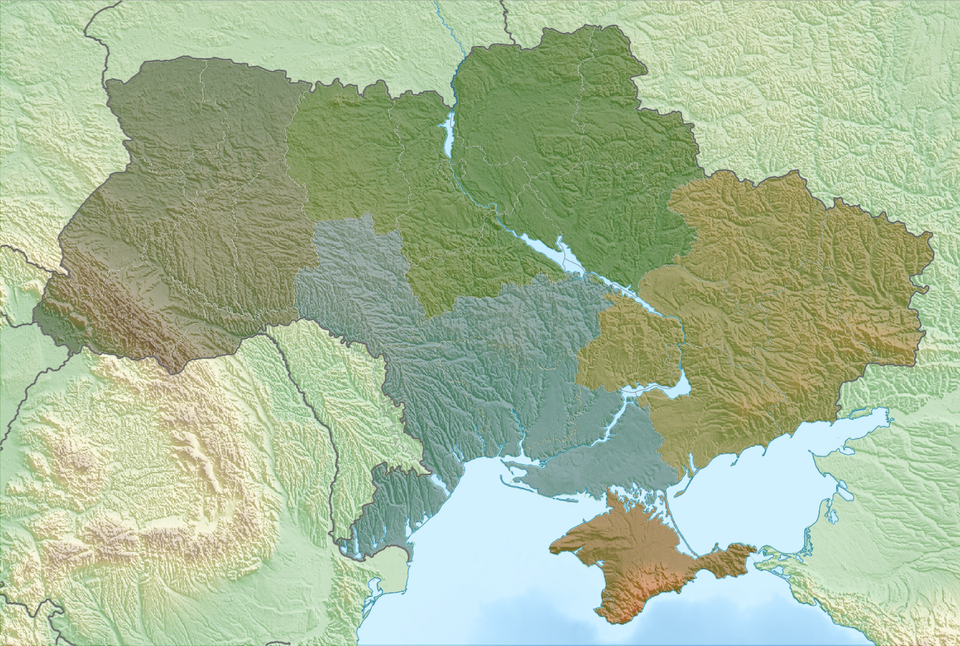
Location of Ukrainian Ground Forces units
Regiments:
units in Italics are directly subordinated to Ground Forces Command
List of commanders[]
Title "Commander-in-chief" (Ukrainian: Головнокомандувач) 1992 – 2005, "Commander" (Ukrainian: Командувач) 2005 – present
- 1992 – 1994 no appointment (see above text)
- 1994 – 1998 Colonel General Vasyl Tymofiyovych Sobkov (uk:Собков Василь Тимофійович)
- 1998 – 2001 Colonel General Petro Ivanovych Shulyak
- 2001 – 2002 Colonel General Oleksandr Ivanovych Zatynayko
- 2002 – 2004 Colonel General Petro Ivanovych Shulyak
- 2004 – 2006 Colonel General Mykola Mykolayovych Petruk
- 2006 – 2007 Lieutenant General Valeriy Semenovych Frolov
- 2007 – 2009 Colonel General Ivan Yuriyovych Svyda
- 2009 – 2014 Colonel General Henadiy Petrovych Vorobyov
- 2014 – 2016 Lieutenant General Anatoliy Sabbatiyovych Pushnyakov
- 2016 – 2019 Colonel General Serhiy Mikolayovych Popko
- 2019 - present Colonel General
Military ranks[]
- As a non-member state, NATO rank codes are not used in Ukraine, they are presented here for reference purposes only
In the new uniforms the Ukrainian Army unveiled in August 2016 the stars that traditionally adorn shoulder straps have been replaced by diamonds.[51] A new set of insignia are being adopted.
General and officer ranks[]
| Rank group | General/flag officers | Field/senior officers | Junior officers | Officer cadet | ||||||||||||||||||||||||||||||||
|---|---|---|---|---|---|---|---|---|---|---|---|---|---|---|---|---|---|---|---|---|---|---|---|---|---|---|---|---|---|---|---|---|---|---|---|---|

|

|

|

|

|

|

|

|

|

|

|
||||||||||||||||||||||||||
| Генерал Heneral |
Генерал-лейтенант Heneral-leytenant |
Генерал-майор Heneral-mayor |
Бригадний генерал Bryhadnyy heneral |
Полковник Polkovnyk |
Підполковник Pidpolkovnyk |
Майор Mayor |
Капітан Kapitan |
Старший лейтенант Starshyy leytenant |
Лейтенант Leytenant |
Молодший лейтенант Molodshyy leytenant |
Kурсант Kursant | |||||||||||||||||||||||||
Other ranks and NCOs[]
| Rank group | Senior NCOs | Junior NCOs | Enlisted | |||||||||||||||||||||||||||||||||
|---|---|---|---|---|---|---|---|---|---|---|---|---|---|---|---|---|---|---|---|---|---|---|---|---|---|---|---|---|---|---|---|---|---|---|---|---|

|

|

|

|

|

|

|

|

|

| |||||||||||||||||||||||||||
| Головний майстер-сержант Holovnyy mayster-serzhant |
Старший майстер-сержант Starshyy mayster-serzhant |
Майстер-сержант Mayster-serzhant |
Штаб-сержант Shtab-serzhant |
Головний сержант Holovnyy serzhant |
Старший сержант Starshyy serzhant |
Сержант Serzhant |
Молодший сержант Molodshyy serzhant |
Старший солдат Starshyy soldat |
Солдат Soldat | |||||||||||||||||||||||||||
Equipment[]
Uniforms[]

The Ukrainian Army unveiled its new uniforms on 24 August 2016 (Independence Day of Ukraine).[51] The new uniforms are modeled on British military styles.[51] They also incorporate details from the uniforms worn by the Ukrainian People's Army.[51] The new cap includes an insignia of a Ukrainian Cossack grasping a cross.[51]
Deployment outside of Ukraine[]
Iraq[]

Ukraine deployed a sizable contingent of troops to the Iraq War, these were stationed near Kut. Ukraine's troop deployment was the second largest of all former Soviet states besides Georgia and they deployed more soldiers to the nation then many members of NATO such as Estonia, Latvia, and Lithuania. Ukraine also suffered the fifth highest casualty toll during the war, with only Polish, Italian, UK, and US forces suffering heavier losses.[53]
From 2003 to 2005 over 1,700 Ukrainian soldiers were deployed to Iraq, the third-largest contingent at the time, they were designated to the 5th Mechanized Brigade (Ukraine), as in Ukraine's mission to Kosovo the troops deployed were contract soldiers and not conscripts. Ukraine began to severely draw down its troop levels in Iraq in 2005 due to mounting casualties and the political toxicity of the conflict. By 2005 only 876 soldiers, roughly half of the original contingent were deployed, by years end troop levels dropped to below 100. In 2008, one year before the official end of the US military mission, President Viktor Yushchenko ordered all remaining troops deployed to Iraq to be returned home and Ukraine's mission to the nation officially over.[54]
Afghanistan[]
Since 2001, Ukraine allowed United States military cargo planes to fly over and refuel on Ukrainian soil on their way to Afghanistan. In 2007 Ukraine deployed a detachment of the 143rd De-mining Center of the Armed Forces of Ukraine to Afghanistan. Ukraine has kept a team of soldiers deployed to Afghanistan as part of ISAF since 2007, these mostly consisted of pilots, medical officers, and bomb disposal experts. Ukrainian pilots were responsible for training the pilots of the Afghan Air Force on the operation of several air craft as Afghanistan's forces consisted of many Soviet designed aircraft such as the Mi-17 with which Ukrainian troops were very familiar with. In 2013, the contingent of troops in Afghanistan totaled 26 troops. As of 2014 the Ukrainian contingent was further drawn down and the team included 8 bomb disposal experts and several medical officers.[55]
Kosovo[]
Ukrainian forces have also been deployed to Kosovo since 2000 as part of the 600 man Polish–Ukrainian Peace Force Battalion. In August 2014, Ukraine ended its mission to Kosovo due to the 2014 Russian invasion of Ukraine.[56]
Africa[]
Ukrainian peacekeeping forces have been deployed to the Democratic Republic of Congo, Liberia, Sudan and South Sudan and Cote d'Ivoire. Ukrainian forces have also been requested to take a more active role in the Northern Mali Conflict of 2012 in battling Islamic forces. One of the largest deployments is the 18th Separate Helicopter Unit of the Armed Forces of Ukraine which consisted of 160 servicemen and four Mi-24P helicopters and was deployed to the Democratic Republic of Congo in 2011.[57]
Military decorations[]

Hero of Ukraine
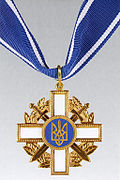
Order For Courage
Veterans[]
Ukraine provides combat veterans with various benefits. Ukrainians who have served in World War II, the Soviet–Afghan War, or as liquidators at the Chernobyl disaster are eligible for benefits such as a monthly allowance, a discount on medical and pharmacy services, free use of public transportation, additional vacation days from work, having priority for retention in case of work layoffs, easier loan access and approval process, preference when applying for security related positions, priority when applying to vocation school or trade school, and electricity, gas, and housing subsidies. Veterans are also eligible to stay at military sanatoriums, provided there is available space. Since gaining independence, Ukraine has deployed troops to Kosovo, Iraq, and Afghanistan gaining a new generation of veterans separate from those who have served in the Soviet forces. Most recently the government passed a law extending veteran benefits to Ukrainian troops participating in the war in Donbas. Moreover, veterans from other nations who move to or reside in Ukraine may be eligible for some of the listed benefits, this provision was likely made to ensure World War II, Chernobyl, and Afghanistan veterans from other Soviet states who moved to Ukraine received similar benefits, however as Ukraine has participated in numerous NATO led conflicts since its independence it is unclear if NATO veterans would be extended these benefits.[58]
Veteran groups are not as developed as in the United States which has numerous well known national organizations such as the Veterans of Foreign Wars. World War II veterans, and even persons who have lived through the war are generally treated with the highest respect. Other veterans are not as well known. Ukrainian veterans from the Soviet War of Afghanistan are strikingly similar to the Vietnam veterans of the United States, although the Soviet Union generally kept the public in the dark through the war, unlike in Vietnam, where coverage was very high. Afghanistan is often labeled as a mistake by the Soviet Union and its successor states, but the lack of media coverage, and the censorship through the war have ensured that many still remain unaware of their nation's involvement in the conflict.[59] Despite Ukraine having the 3rd largest contingent of troops in Iraq in 2004, few also realize that their nation has many veterans of the Iraq war.
Soldiers that took part in the war in Donbas can receive free land plots.[60]
On 22 November 2018 the (Ukrainian) Ministry for Veterans Affairs was officially established.[61]
See also[]
- Military ranks of Ukraine
- Ukrspetsexport
- KMDB
- Malyshev Factory
Notes[]
- ^ According to the State Program of the Ukrainian Armed Forces reform and development to 2005, the ground forces were to have the biggest ratio of personnel of all services (up to 54%). This ratio was to be based on the missions assigned to the armed forces, and also on the fact that the economy of Ukraine could not support any larger troop numbers. However, the ground forces still has priority in the number of personnel, weapons, military equipment development priorities and the development of their future systems, which were to correspond to modern warfare requirements. The ground forces were planned to closely coordinate their assignments with other army branches, engaging appropriate military arts and equipment. They were to also be involved in law enforcement activities during emergencies, dealing with consequences of technological and natural disasters, providing military assistance to other countries, engaging in international military cooperation activities (UN), and participating in international peacekeeping operations according to international agreements.
- ^ It was reported on 27 July 2005 that '..[o]ver 70 per cent of planned work on [the] disbandment of the Ukrainian armed forces' Northern Operational Command has been completed,' according to the Defence Ministry's press service.[20]
References[]
Citations[]
- ^ Jump up to: a b "Полторак поставив сухопутні війська за приклад реформ в Україні". 13 December 2016. Archived from the original on 2018-03-01. Retrieved 2018-03-01.
- ^ Culture Smart! Ukraine by Anna Shevchenko, Kuperard, 2006, ISBN 978-1-85733-327-5
- ^ Jump up to: a b c d In the Army Now: Answering Many Why's Archived 2015-01-08 at the Wayback Machine, The Ukrainian Week (8 July 2014)
- ^ Jump up to: a b Ukraine must stop importing Russian weapons, switch to NATO standards Archived 2014-12-18 at the Wayback Machine, Interfax-Ukraine (18 December 2014)
- ^ Poroshenko says military hardware will bring Ukraine's victory closer Archived 2016-08-24 at the Wayback Machine, Interfax-Ukraine (24 August 2016)
- ^ Adam Taylor (3 March 2014). "Ukraine's military is far smaller than Russia's, but there are 3 reasons it might not be so easy to crush". The Washington Post. Archived from the original on 22 November 2017. Retrieved 19 March 2016.
- ^ Jump up to: a b Olga Rudenko (6 May 2014). "Thousands dodge Ukraine army in fight with rebels". USA Today. Archived from the original on 23 March 2016. Retrieved 19 March 2016.
- ^ Ukrainian army composed of 75% contract servicemen - president Archived 2016-08-25 at the Wayback Machine, Interfax-Ukraine (24 August 2016)
- ^ "Archived copy". Archived from the original on 2017-12-25. Retrieved 2017-12-24.CS1 maint: archived copy as title (link)
- ^ Abbott, P. & E. Pinak Ukrainian Armies 1914–55 (Osprey Publishing Ltd., 2004), ISBN 1780964013, 9781780964010
- ^ "The Ukrainian Military: From Degradation to Renewal - Foreign Policy Research Institute". www.fpri.org. Retrieved 2021-07-22.
- ^ ANALYSIS: Ukraine adopts program for military reform Archived 2005-11-18 at the Wayback Machine, 03/02/1997
- ^ See references at 6th Guards Tank Army and 6th Army Corps (Ukraine). On 1 December 1993, 8th Guards Tank Army became 8th Army Corps.
- ^ Jane's Sentinel: Ukraine, 1994
- ^ Yuriy Yurchnya, 'The Armed Forces of Ukraine,' DCAF, 2010, 89.
- ^ Andrew Duncan, 'Ukraine's forces find that change is good,' Jane's Intelligence Review, April 1997, 162–3.
- ^ Stephen D. Olynyk, Ukraine as a Post-Cold War Military Power Archived 2006-09-26 at the Wayback Machine, Joint Force Quarterly, Spring 1997, 93.
- ^ "Archived copy" (PDF). Archived from the original (PDF) on 2007-11-27. Retrieved 2007-09-24.CS1 maint: archived copy as title (link) , page 4 of 136
- ^ Yurchnya, 2010, 91.
- ^ , 'Ukrainian army's Northern Operational Command being disbanded,' Interfax-AVN military news agency web site, Moscow, in English 1152 gmt 27 Jul 05 via BBC Monitoring.
- ^ Ukraine crisis timeline Archived 2014-06-03 at the Wayback Machine, BBC News
- ^ "Kiev announces plans to withdraw Ukrainian troops from Crimea". The Guardian. Archived from the original on 26 October 2014. Retrieved 31 January 2015.
- ^ "Russia has sent 6,000 troops to Crimea says Ukraine". www.thejournal.ie. Archived from the original on 12 August 2015. Retrieved 31 January 2015.
- ^ "Ukraine orders all troops out of Crimea". CBS News. Archived from the original on 8 July 2014. Retrieved 31 January 2015.
- ^ Jump up to: a b "Ukraine Battles to Rebuild a Depleted Military". Wall Street Journal. Archived from the original on 23 February 2015. Retrieved 31 January 2015.
- ^ (in Ukrainian) After the annexation of Crimea left only 10% of staff SBU Archived 2016-02-09 at the Wayback Machine, Ukrayinska Pravda (February 8, 2016)
- ^ "Abandoned Donbas Battalion fights on". Kyiv Post. 24 August 2014. Archived from the original on 25 August 2014. Retrieved 27 August 2014.
- ^ "Why is Ukraine's Army So Appallingly Bad?". The New Republic. 9 May 2014. Archived from the original on 4 July 2014. Retrieved 20 September 2014.
- ^ Ukraine’s Toughest Fight: The Challenge of Military Reform Archived 2018-12-03 at the Wayback Machine, Carnegie Endowment for International Peace (FEBRUARY 22, 2018)
- ^ Jump up to: a b Report on the human rights situation in Ukraine 16 November 2017 to 15 February 2018 "Within the reporting period, OHCHR documented 115 cases of credible allegations of unlawful or arbitrary detention, torture, ill-treatment and/or sexual violence committed on both sides of the contact line." Archived 3 May 2018 at the Wayback Machine, OHCHR (page 6)
- ^ Jump up to: a b Ukrainian Armed Forces 2006 White Book p.25 Archived 2007-11-27 at Archive-It
- ^ Ukrainian Armed Forces 2006 White Book p.26 Archived 2007-11-27 at Archive-It
- ^ Explainer: How Do Russia's And Ukraine's Armies Compare? Archived 2016-10-23 at the Wayback Machine, Radio Free Europe (6 March 2014)
- ^ Jump up to: a b Ukrainian army struggling with its training system Archived 2016-10-23 at the Wayback Machine, Kyiv Post (14 September 2016)
- ^ "Ukrainian Armed Forces 2007 White Book p.42" (PDF). Archived from the original (PDF) on 2008-09-10. Retrieved 2008-05-13.
- ^ "Головна :: Державний університет телекомунікацій". Archived from the original on 2016-03-30. Retrieved 2016-01-20.
- ^ (in Ukrainian) Minister of Defence visits 1st Armored Brigade Archived 2011-06-07 at the Wayback Machine
- ^ (in Ukrainian) People's Army Magazine Archived 2011-07-16 at the Wayback Machine
- ^ https://www.ukrmilitary.com/2020/01/tanks.html#more
- ^ "Fighting Back: How Ukraine Upgraded Its T-64BM Bulat Tanks to Stop Russia". 9 January 2020.
- ^ "Военные на днях получат сотню новых танков Т-80 - советник президента (фото)".
- ^ IISS Military Balance 1992/3, p 86, and Military Balance 2008, p 188
- ^ "Ukrainian army launches new light infantry brigade | KyivPost - Ukraine's Global Voice". 13 May 2019.
- ^ "Structure of Ukrainian Armed Forces". Archived from the original on 2007-10-07. Retrieved 2007-08-29.
- ^ "Archived copy". Archived from the original on 2007-03-13. Retrieved 2007-11-24.CS1 maint: archived copy as title (link)
- ^ "Ukrainian Armed Forces White Book 2011" (PDF). Archived from the original (PDF) on May 20, 2013. Retrieved April 10, 2013. Cite journal requires
|journal=(help) - ^ Jump up to: a b c d e f g h i j k l m n o p q r s t u v w x y z aa ab ac ad ae af ag ah ai aj ak al am an ao ap aq ar as at au av Dovbaka Nicholas Ihorovych. "National defense" (in Ukrainian). Archived from the original on 12 March 2016. Retrieved 1 February 2016.
- ^ Jump up to: a b c d e f g h i j k l m n o p q r s t u v w x y z aa ab ac ad ae af ag ah ai aj ak al am an ao ap aq ar as at au av aw ax ay az ba Сухопутні війська (in Ukrainian). Archived from the original on 27 June 2016. Retrieved 4 July 2016.
- ^ Новостворена танкова бригада склала іспит на полігоні "ШИРОКИЙ ЛАН" [New Tank Brigade passes test at training ground "Shyrokyi Lan"]. Ministry of Defence of Ukraine (in Ukrainian). 28 December 2015. Archived from the original on 7 February 2016. Retrieved 22 March 2016.
- ^ "Зміни, що чекають військовий резерв України". Archived from the original on 2017-11-16. Retrieved 2017-11-10.
- ^ Jump up to: a b c d e Fashion statement: Ukrainian troops debut post-Soviet uniforms Archived 2016-08-29 at the Wayback Machine, The Washington Times (25 August 2016)
- ^ Jump up to: a b "НАКАЗ 20.11.2017 № 606". zakon.rada.gov.ua (in Ukrainian). Ministry of Justice of Ukraine. 13 December 2017. Retrieved 2 June 2021.
- ^ "Ukraine withdraws last troops from Iraq". Reliefweb. 2005-12-05. Archived from the original on 2014-09-13. Retrieved 2014-09-13.
- ^ "Ukrainians complete mission in Iraq". Army Times. 2008-11-08. Archived from the original on 2014-09-13. Retrieved 2014-09-13.
- ^ "Українського контингенту Міжнародних сил сприяння безпеці в Афганістані". Ukraine Ministry of Defense. 2014-09-18. Archived from the original on 2014-09-18. Retrieved 2014-09-18.
- ^ "Украина возвращает из Косово еще 100 миротворцев". Ukrinform. 2014-08-15. Archived from the original on 2014-08-17. Retrieved 2014-09-18.
- ^ "Ukraine and Africa. Ukrainian Peacekeepers in Africa". Borysfen Intel. 2014-08-15. Archived from the original on 2014-12-13. Retrieved 2014-09-19.
- ^ "Benefits for the servicemen of the ATO". Харькова Тимохов. 2014-09-08. Archived from the original on 2014-09-14. Retrieved 2014-09-13.
- ^ "Vietnam Veterans Against the War: THE VETERAN: Afghanistan Veteran Once Removed". Archived from the original on 14 September 2014. Retrieved 30 October 2014.
- ^ Soldiers participating in ATO get 863 land plots of 394 ha, 45% of petitions satisfied – land agency Archived 2014-12-16 at the Wayback Machine, Interfax-Ukraine (16 December 2014)
- ^ Ukraine parliament appoints Markarova, Friz ministers, UNIAN (22 November 2018)
Sources[]
- International Institute for Strategic Studies, The Military Balance 2006.
- Yuriy Yurchnya, 'The Armed Forces of Ukraine,' Geneva Centre for DCAF, 2010.
Further reading[]
- Andrew Duncan, 'Ukraine's forces find that change is good,' Jane's Intelligence Review, April 1997, 162–165.
- Ben Lombardi, Ukrainian armed forces: Defence expenditure and military reform, Journal of Slavic Military Studies, Vol. 14, No. 3, version of record date 18 Dec 2007.
- James Sherr, Ukraine's Defence Reform: An Update, Conflict Studies Research Centre, 2002
External links[]
- The Army of the Armed Forces of Ukraine at the Ministry of Defence of Ukraine
- Armament of Ukrainian Ground Forces at the Ministry of Defence of Ukraine
- Ukraine: Ground Forces Equipment
- Vepr Assault Rifle
- The Ukrainian Army – uarmy.iatp.org.ua
- Analysis of the Ukrainian Security Policy
- Ukraine's strategic Defence bulletin
- May 2016 analysis by Glen Grant, a former colonel in the British Army and lecturer at Riga Business School about powerfulness of Ukraine’s armed forces, produced by 5 Kanal
- Military of Ukraine
- Armies by country
- 1991 establishments in Ukraine
- Ground Forces of Ukraine
